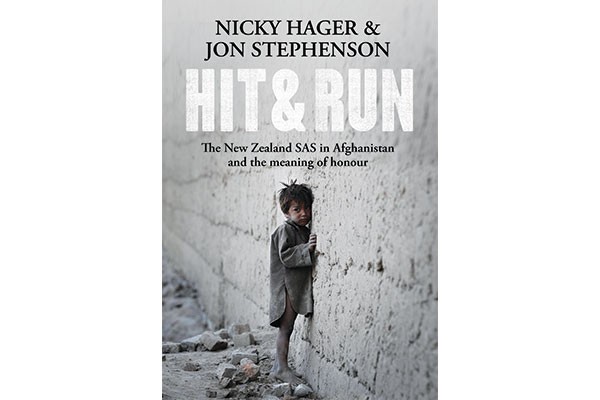Nicky Hager and Jon Stephenson, two of New Zealand’s most renowned investigate journalists, claim that a 2010 NZSAS-led raid in Afghanistan killed six civilians and injured 15 more – contrary to the official story.
The allegation is made in a book titled Hit and Run: The New Zealand SAS in Afghanistan and the meaning of honour, which they unveiled at Unity Books last week in Wellington.
The book is not completely conclusive but nonetheless offers clear questions that need answering immediately. The evidence presented shows the need for a further inquiry through an official, independent and transparent process.
The raid took place in the isolated and mountainous Tirgiran valley, about fifty kilometres from the headquarters of New Zealand’s Provincial Reconstruction Team (PRT) in Bamiyan province. The SAS force was supported by Afghan commandos and US helicopters and raided two villages, Naik and Khak Khuday Dad, located in the valley in the early morning of 22 August 2010. The mission was signed off by then Prime Minister John Key.
The raid came nineteen days after the killing of Lieutenant Tim O’Donnell by a roadside bomb that hit a vehicle patrol. It was a huge blow to morale; Lt. O’Donnell, a young decorated soldier, was the first of what would be eight combat deaths in Afghanistan before our withdrawal in April 2013. The SAS believed that, based on what the book calls “flimsy evidence”, they would find the local insurgent group responsible.
“But the group wasn’t there,” Hager and Stephenson say, “and the 21 people killed or wounded in the operation were all civilians – mostly women and children.”
The New Zealand Defence Force (NZDF) were aware of the raid’s failure and civilian victims, yet a different story was sold to the public: that it was a success, that the enemy combatants had been found and killed. In April 2011, the NZDF said that a joint investigation by the Afghan ministries of defence and the interior, and the International Security Assistance Force (ISAF) concluded that the allegations of civilian casualties were unfounded.
It’s worth noting that Jon Stephenson has been covering the War on Terror since its inception and Hager has explored the darkness beyond our military’s friendly face before, in his 2011 book Other People’s Wars. Time and again the questions and accusations Hager has raised are dismissed as “left-wing conspiracy theories” by the government and their friends in opinion columns – but he has always been proved correct.
The fallout from Hit and Run further highlights the need for an official investigation; former Defence Minister Wayne Mapp, talking with Newshub last week, admitted that civilians were killed in the raid, contradicting comments made by himself and the Defence Force in 2011, when the raid became public knowledge.
“One of the disasters of war is these terrible things can happen,” Mapp said Wednesday, while also not denying he had told a friend that the raid was New Zealand’s “biggest and most disastrous operation - a fiasco,” a quote attributed to him in the book.
As of writing, both former PM John Key and current PM Bill English have yet to comment. The NZDF has commented by referring to its 2011 press release that denied any civilian deaths.
The mighty phrase ‘war crimes’ has been floated around the media since Hit and Run’s release, but we should avoid getting bogged down by both its enormity and its legal technicalities. We should stay grounded and call for an official investigation, independent enough of both the NZDF and the government to produce credible findings.
Stephenson says, “there was a sort of air of tension – almost revenge in the air” among Kiwi defence personnel after the killing of Lt. O’Donnell and, shortly afterwards, US-led command gave the go ahead for the mission, providing Apache helicopter support that allegedly gunned down fleeing civilians.
“Revenge” missions were not unique during the US-led wars in Iraq and Afghanistan, according to human rights groups and internal military investigations (for example the 2012 Panjwai massacre in Afghanistan or the 2005 Haditha massacre in Iraq).
Indeed, critics often claim the initial foundation for the whole War on Terror was vengeance; a perpetual revenge mission carried out by a West traumatised by the horror of 9/11. In this respect, the SAS raids in Tirgiran are a microcosm of something larger: the infinite, global cycle of violence and the insatiable anger formed while watching the towers fall or witnessing your village burn.
While the exact personal motivations that set the SAS raid in motion – and how that dictated tactics – will be difficult to determine, the fact remains that the Hit and Run account sits in stark contrast to the official line and that alone should warrant further investigation, especially after Mapp’s comments on the matter.
“It’s either incompetence at a biblical level or there’s been [an] element of deliberate cover-up,” Jon Stephenson told reporters at the book launch.
Indeed, the classic Watergate-esque questions arise: What did X know and when did they know it? How and in what scope were John Key and the then Chief of the Defence Force, Lieutenant General Sir Jerry Mateparae briefed before giving the raid the go-ahead? What was the precise nature of the intelligence acted upon? Who oversaw the NZDF’s later denials and on what grounds? Why was the Afghan-ISAF investigation incorrect? Did 3-year-old Fatima, one of the six dead, have to die? Who killed her and why?



